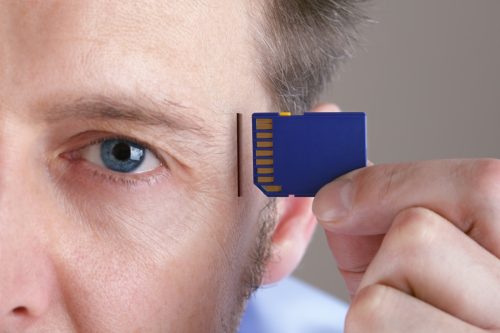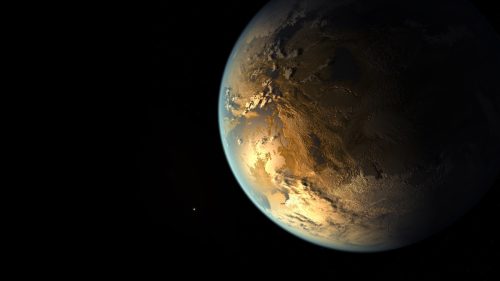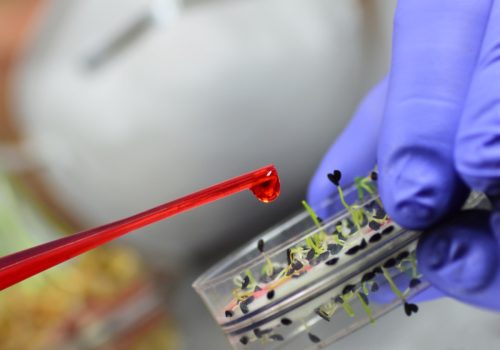32 Greatest Scientific Discoveries of Our Lifetime

We usually think about the greatest scientific discoveries as breakthroughs of the distant past—Isaac Newton’s law of universal gravitation, or Charles Darwin striking on the concept of natural selection. But scientific innovations are happening all the time, with the world as we understand it being reconsidered and revised every day, often without our even realizing it happened. Indeed, we more modern humans have struck on some surprising findings and changed our view of the world. From advancements in artificial intelligence to reusable rockets, here are 32 of the most significant discoveries uncovered in the recent past.
READ THIS NEXT: 55 Fascinating World Facts You Need to Know.
32 Greatest Recent Scientific Breakthroughs
For centuries, experts have been working hard to stretch our scientific resources far and wide. Below, we’ll detail some of the most significant discoveries the community has helped bring forward just over the past few decades. Read on and think hard about what strikes you as the most important scientific discovery of your lifetime.
1. A Pluto-Sized Planet

In 2005, scientists discovered the second-largest dwarf planet in the solar system. With a mass about 27 percent larger than Pluto (though a diameter slightly smaller), and about three times farther from the Sun than Pluto, it was spotted during routine observations at California’s Palomar Observatory.
It was also discovered that the planet has one moon, which was named “Eris” after the Greek goddess.
2. A Super-Earth

If a dwarf planet doesn’t seem that impressive, how about a “Super-Earth”? That was a finding by scientists just a few years ago, who reported finding a planet about 1.6 times the size of Earth, about 200 light-years from Earth that may be able to sustain life.
Named K2-155d (not the catchiest title), it revolves around a superhot dwarf star, and the researchers believe it may contain liquid water on its surface.
3. Fast Radio Burst

No, this isn’t a term for short, loud radio commercials. First discovered in 2007, these are quick signals from space, which may be signals coming from collapsing black holes, energy from something called cosmic strings, or even alien messages.
As Smithsonian explains, researchers now believe “that the bursts likely pass through a field of magnetized plasma, altering the signal.”
That process, called Faraday rotation, “twists” the polarization of certain radio frequencies in a certain way. Researchers found that the twist on FRB 121102 is 500 times greater than that found on any other FRB, which means the signals had to pass through an incredibly powerful, highly magnetic dense plasma field.
4. Memory Manipulation

It seems like a sci-fi movie, but neuroscientists in 2014 figured out how to implant false memories. The duo manipulated a mouse’s brain cells, encoding the memory of receiving a shock when placed in a small metal box.
Though it never actually received a shock, when placed in the box, the mouse with the implanted memory reacted in fear.
READ THIS NEXT: 30 Amazing Facts That Will Change the Way You View the World.
5. Grid Cells

In 2005, researchers Edvard Moser and May-Britt Moser discovered grid cells in the brain—a kind of neuron that allows us to map out space.
The New York Times helpfully explains the significance of these: “Imagine that you are watching a rat running around on a floor completely covered with hexagonal tiles, all the same size. Every time the rat passes the point of one of the 60-degree angles, you press a button to send out an electrical signal. You, in essence, are a grid cell, except that you can see the tiled floor, while the grid cell has no eyes, is buried in the middle of the brain, and functions wherever the rat goes, no matter what the floor looks like.”
6. A Computer Chip That Imitates the Human Brain

As we move ever closer to The Singularity, IBM helped us take a significant step forward in 2014, with the release of the SyNAPSE computer chip, which simulates the firing of synapses done by a person’s brain (the chip contained 5.4 billion transistors while consuming 10,000 times less power than a more conventional computer chip, all the size of a postage stamp).
“There is the potential here to really open up a spree of tremendous innovation,” Dharmendra Modha, chief scientist of brain-inspired computing at IBM, told The Guardian. He gave the example of a phone that could understand where it is, who is speaking, and what they are doing.
7. The Ability to Control a Mechanical Hand With Thoughts

Like something out of a Marvel movie, Italian amputee Pierpaolo Petruzziello was outfitted in 2009 with a biomechanical hand that connected to his arm nerves with wires and electrodes—and which he was able to control by thinking about it.
It was the first time a patient was able to make such complex movements with nothing but their mind.
8. Termite-Inspired Robots

Termites usually bring to mind disaster for homebuilding, but a team of Harvard researchers used the cooperative interactions of termites—which build complex soil structures by taking cues from one another and the surrounding environment—as the inspiration for designing robots, equipping them with sensors that allowed them to respond to their surroundings and other robots, without the need for human supervision.
As Live Science explains, “This type of collective intelligence also means the same instructions can be carried out by a small team of five robots, or a much larger crew of 500, the researchers said. In the future, similar robotic systems could be used for construction projects deemed too dangerous for humans, or for simple construction tasks on Mars.”
9. Strong Evidence of Liquid on Mars

Dark streaks on the planet Mars, disappearing and reappearing depending on the season, were spotted first in 2010 by a University of Arizona undergraduate and are now believed to be the result of flowing, liquid saltwater.
“A big question swirls around the origin of that water: Where is it coming from?” asks National Geographic. “One possibility is that the seeps are fueled by an aquifer or melting subsurface ice. These scenarios would have Mars essentially sweating, with salt water seeping from its pores and trickling down slopes as the planet warms.”
10. Turning Regular Cells Into Stem Cells

Stem cells are important for health and biological research since they can turn into any other type of cell in your body—white blood cells, nerve cells, you name it. But it was not until 2006 that we learned that any cell can be reprogrammed into a stem cell. That discovery, by Shinya Yamanaka, PhD, was a major breakthrough for regenerative modern medicine.
READ THIS NEXT: 17 Totally Crazy Twins Facts That Will Blow Your Mind.
11. Human Genome Project

Mapping and identifying every gene in the human family tree was a massive project with major implications for medicine, biology, and genetics, formally begun in 1990 and completed in 2003, but stretching long before and after.
12. TRAPPIST-1

NASA researchers recently identified a system of seven Earth-sized planets orbiting a single star—three of which were located in the “habitable zone” where a planet is most likely to have liquid water. It was called TRAPPIST-1, named for the Transiting Planets and Planetesimals Small Telescope.
“This discovery could be a significant piece in the puzzle of finding habitable environments, places that are conducive to life,” Thomas Zurbuchen, associate administrator of the agency’s Science Mission Directorate in Washington, said at the time. “Answering the question ‘Are we alone?’ is a top science priority and finding so many planets like these for the first time in the habitable zone is a remarkable step forward toward that goal.”
13. Gravitational Waves

Albert Einstein predicted in his Theory of General Relativity that mass actually curves space-time, but it wasn’t until 2016 that scientists were able to confirm it when CalTech researchers observed these ripples—created during what the researchers called a “cataclysmic event in the distant universe”—likely during the “merger of two black holes to produce a single, more massive spinning black hole.”
It marked the first observation of gravitational waves and a confirmation of Einstein’s theory a century after he suggested it.
14. AI for Musical Artists

Just as artificial intelligence has revolutionized the diagnostic sphere with access to all the big data and electronic medical records from around the world, the same technology can be used to elevate other industries. The introduction of text-to-image generators affords anyone from urban planners and reconstructive surgeons to visual artists the ability to realize their ideas more timely and accurately than ever before.
As Ross Anderson of The Atlantic describes it, “This is the most exciting new technology in the AI space since natural-language translation.”
15. The Oldest Art in the World

Through radiocarbon dating, scientists in 2014 determined that cave paintings in the Maros district of Sulawesi, Indonesia were older than previously believed—dating back about 40,000 years. That made its depiction of an ancient “pig-deer” or babirusa the oldest figurative art in the world.
16. Reusable Rockets

That mad genius Elon Musk has found a way to reuse and recycle rockets after sending them into space, landing them safely on a barge in the ocean—saving the billions of dollars it costs to fully replace such technology and taking us a step closer to affordable space travel.
17. Genome Sequencer 20 System

While the Human Genome Project gets much of the attention, the work of Jonathan Rothberg and his 454 Life Sciences biotech company is also plenty important—the effort to make human genome sequencing affordable enough that doctors could use it as a diagnostic tool.
It was able to sequence vastly more DNA data for a fraction of the price compared to the previous methods and it helped pave the way for more widespread gathering and use of genetics data.
READ THIS NEXT: 23 Facts About Your Brain That Will Blow Your Mind.
18. Higgs Boson

Also known as the “God Particle,” its importance is summed up well by Stephen Reucroft of Northeastern University: “Over the past few decades, particle physicists have developed an elegant theoretical model (the Standard Model) that gives a framework for our current understanding of the fundamental particles and forces of nature. One major ingredient in this model is a hypothetical, ubiquitous quantum field that is supposed to be responsible for giving particles their masses (this field would answer the basic question of why particles have the masses they do–or indeed, why they have any mass at all).”
Reucroft continues, “This field is called the Higgs field. As a consequence of wave-particle duality, all quantum fields have a fundamental particle associated with them. The particle associated with the Higgs field is called the Higgs boson.”
And, to a certainty of 99.999 percent, it was discovered in 2012.
19. Large Hadron Collider

The reason physicists and engineers were able to find the Higgs boson was that they were using the Large Hadron Collider, the most powerful particle collider in the world. Also the largest, it was first tested in 2008 and it has since been upgraded with better detectors and pre-accelerators.
20. Protease Inhibitors

The drug that turned the tide on HIV was first approved in 1996. Protease inhibitors prevent the virus from multiplying by getting in the way of the enzyme that otherwise permits the cells to replicate. This was a major breakthrough at the time and continues to be an important component of managing HIV/AIDS.
21. Cloned Mammal

It was just a little over 25 years ago that we first heard of “Dolly the Sheep,” the first mammal cloned from an adult somatic cell, using nuclear transfer. The wooly creature came from three mothers—one that provided an egg, one that provided DNA, and one that carried the embryo to term—and her birth kicked up plenty of controversy when it was first announced.
She lived a long, by all accounts happy life and produced six lambs of her own.
22. A Black Hole That’s 12 Billion Times as Big as the Sun

The Sun is pretty massive, but it’s got nothing on SDSS J0100+2802. That catchy-named “hyperluminous quasar” holds one of the most massive black holes in the universe—about 12 billion times the mass of the Sun with a diameter of 70.9 billion kilometers.
“By comparison, our own Milky Way Galaxy has a black hole with a mass of only 4 million solar masses at its center; the black hole that powers this new quasar is 3,000 times heavier,” co-author Xiaohui Fan, PhD, from the University of Arizona, explained in 2015 when the discovery was announced.
23. Toumai Skull

In 2002, researchers found the oldest hominid fossil yet discovered, in central Africa. The 7 million-year-old Sahelanthropus tchadensis was primitive but with hominid traits such as a flat face and worn-down canine teeth. It provided insight into a possible common ancestor between apes and humans and fueled the idea that evolution had been occurring throughout Africa, rather than being localized to specific regions, as had been initially thought.
24. RNA Gene Switches

Researchers discovered small RNAs that serve as a kind of genetic switch, bonding to a small molecule and changing its production of proteins. It’s been a major discovery in the field of genetics and the scientific community has since developed its own synthetic versions of them.
25. Earth’s Older Cousin

In July 2015, NASA reported that it had spotted Earth’s “bigger, older cousin.” Dubbed Kepler 452b, it is 60 percent larger in diameter than Earth with a temperature similar to our planet’s. NASA described the discovery of the planet and 11 other small planets as a “milestone in the journey to finding another ‘Earth.'”
26. A New Class of Antibiotic

As developments in antibiotics have stagnated and deaths due to antibiotic resistance have risen (to as many as 700,000 globally), the discovery of teixobactin was welcome news when announced in 2015. Through a new method, extracting drugs from dirt-dwelling bacteria, the antibiotic was found to overcome many once-common diseases and infections that other antibiotics would be unable to.
27. A New Species of Monkey

Who doesn’t love playful monkeys? And who wouldn’t be delighted to learn that there is a new species of monkey in the world?
In June 2007, researchers found the species Cercopithecus lomamiensis, more commonly known locally as “lesula,” in the Democratic Republic of Congo—only the second new species of African monkey to be discovered in the past 30 years.
READ THIS NEXT: 75 Weird Animal Facts Everyone Should Know.
28. Artificial Life

One of the men behind the Human Genome Project, Craig Venter, was also involved in the creation of the first artificial organism—the genome of a bacteria that they created from scratch and is considered the “first synthetic life form.”
29. Artificial Womb

Up there with a fully invented life form, is the bag of fluids that imitated a womb and successfully grew a baby sheep last year. The breakthrough eliminates the health risk of pregnancy and presents a more natural environment in which premature infants can continue to develop.
30. Hybrid Vehicles

Electric cars had been plugging along for years, without getting much of a hold in the market—largely due to their reputation as slow-moving and constantly in need of recharging. The launch of the Toyota Prius early in the 21st century changed the math on this, by leveraging electricity without sacrificing the speed or comfort of gas.
The world has since become much more comfortable with electric.
31. Progress Toward a Universal Flu Vaccine

While we are still working on the goal of a universal flu vaccine, things do seem to be moving in the right direction. The vaccines currently in circulation only protect against four strains of the virus, but researchers say they’ve been able to immunize animals against all 20 known influenza A and B strains.
To make the vaccine, scientists are looking to the same mRNA technology used to create COVID inoculation products.
32. Human-Pig Hybrid

This isn’t some kind of Dr. Moreau situation: The human-pig hybrid was developed with the goal of one day allowing us to grow our own organs inside of an animal instead of relying on a donor. Human stem cells were implanted into a pig embryo and removed several weeks later for analysis.
Wrapping Up
That’s it for now! What do you think is the greatest scientific discovery outlined above? Let us know on social media, and you can also sign up for our newsletter so you don’t miss out on what’s next!
- Source: https://solarsystem.nasa.gov/planets/dwarf-planets/eris/in-depth/
- Source: https://www.genome.gov/human-genome-project
- Source: https://www.nasa.gov/press-release/nasa-telescope-reveals-largest-batch-of-earth-size-habitable-zone-planets-around/
- Source: https://www.ncbi.nlm.nih.gov/books/NBK548893/
- Source: https://www.nasa.gov/press-release/nasa-kepler-mission-discovers-bigger-older-cousin-to-earth/
- Source: http://journals.plos.org/plosone/article?id=10.1371/journal.pone.0044271
- Source: https://www.energy.gov/articles/history-electric-car